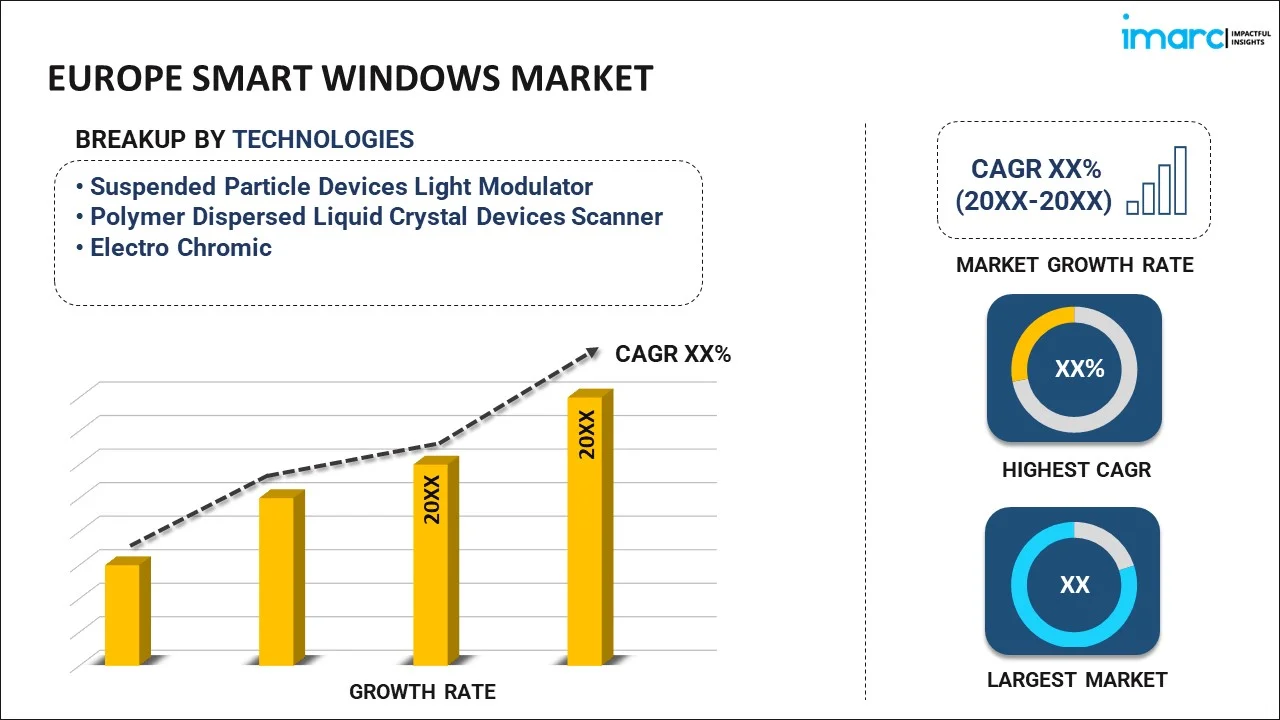
Europe Smart Windows Market Report by Technology (Suspended Particle Devices Light Modulator, Polymer Dispersed Liquid Crystal Devices Scanner, Electro Chromic), Type (OLED Glass, Self-Dimming Window, Self-Repairing), Application (Residential, Commercial, Industrial, Transport), and Country 2025-2033
Market Overview:
The Europe smart windows market size reached USD 463.8 Million in 2024. Looking forward, IMARC Group expects the market to reach USD 1,290.9 Million by 2033, exhibiting a growth rate (CAGR) of 11.69% during 2025-2033.
|
Report Attribute
|
Key Statistics
|
|---|---|
|
Base Year
|
2024
|
|
Forecast Years
|
2025-2033
|
|
Historical Years
|
2019-2024
|
|
Market Size in 2024
|
USD 463.8 Million |
|
Market Forecast in 2033
|
USD 1,290.9 Million |
| Market Growth Rate 2025-2033 | 11.69% |
Smart windows are electronically powered windows that alter their optical power when exposed to light, heat or voltage. They are also known as switchable windows as the visibility of these windows can be changed from transparent to opaque. They are manufactured using electrochromic, liquid crystals or suspended particle glass. Smart windows also regulate the amount of light entering the room and thereby aid in minimizing and conserving energy in buildings. As a result, they find extensive applications in automobiles and residential and commercial complexes.
Significant growth in the construction industry, along with the increasing awareness regarding the benefits of smart windows among the masses, such as energy conservation, is one of the key factors creating a positive outlook for the market. In addition to this, the increasing demand for smart windows in automobiles is also contributing to the market growth. They are installed in electric cars to maintain the inner temperature, thereby enhancing the comfort and convenience for the passengers. Other factors, including the implementation of favorable government policies promoting the use of energy-efficient systems, are anticipated to drive the market further across the continent.
Key Market Segmentation:
IMARC Group provides an analysis of the key trends in each sub-segment of the Europe smart windows market report, along with forecasts at the regional and country level from 2025-2033. Our report has categorized the market based on technology, type and application.
Breakup by Technology:

- Suspended Particle Devices Light Modulator
- Polymer Dispersed Liquid Crystal Devices Scanner
- Electro Chromic
Breakup by Type:
- OLED Glass
- Self-Dimming Window
- Self-Repairing
Breakup by Application:
- Residential
- Commercial
- Industrial
- Transport
Breakup by Country:
- Germany
- France
- United Kingdom
- Italy
- Spain
- Others
Competitive Landscape:
The competitive landscape of the industry has also been examined along with the profiles of the key players.
Report Coverage:
| Report Features | Details |
|---|---|
| Base Year of the Analysis | 2024 |
| Historical Period | 2019-2024 |
| Forecast Period | 2025-2033 |
| Units | Million USD |
| Segment Coverage | Technology, Type, Application, Country |
| Countries Covered | Germany, France, United Kingdom, Italy, Spain, Others |
| Customization Scope | 10% Free Customization |
| Post-Sale Analyst Support | 10-12 Weeks |
| Delivery Format | PDF and Excel through Email (We can also provide the editable version of the report in PPT/Word format on special request) |
Key Questions Answered in This Report
The Europe smart windows market was valued at USD 463.8 Million in 2024.
We expect the Europe smart windows market to exhibit a CAGR of 11.69% during 2025-2033.
The increasing adoption of smart windows in automobiles, along with the rising product integration with Internet-of-Things (IoT) for improved manageability and advanced configuring abilities, is currently catalyzing the Europe smart windows market.
The sudden outbreak of the COVID-19 pandemic had led to the implementation of stringent lockdown regulations across several European nations resulting in the temporary closure of numerous manufacturing units for smart windows.
Based on the technology, the Europe smart windows market can be segmented into suspended particle devices light modulator, polymer dispersed liquid crystal devices scanner, and electro chromic. Currently, electro chromic technology holds the majority of the total market share.
Based on the type, the Europe smart windows market has been divided into OLED glass, self-dimming window, and self-repairing. Among these, self-dimming window exhibits a clear dominance in the market.
Based on the application, the Europe smart windows market can be categorized into residential, commercial, industrial, and transport. Currently, the transport sector accounts for the largest market share.
On a regional level, the market has been classified into Germany, France, United Kingdom, Italy, Spain, and Others, where Germany currently dominates the market.
Need more help?
- Speak to our experienced analysts for insights on the current market scenarios.
- Include additional segments and countries to customize the report as per your requirement.
- Gain an unparalleled competitive advantage in your domain by understanding how to utilize the report and positively impacting your operations and revenue.
- For further assistance, please connect with our analysts.
 Inquire Before Buying
Inquire Before Buying
 Speak to an Analyst
Speak to an Analyst
 Request Brochure
Request Brochure
 Request Customization
Request Customization




.webp)




.webp)












